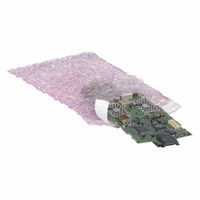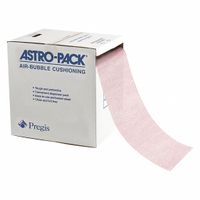Call +(254) 703 030 000 / 751 483 999 / 721 704 777
- Home
- Packaging Shipping
- Protective Packaging
- Anti Static Packaging
- Anti Static Bubble
.....Read More
Frequently Asked Questions
What is anti-static bubble packaging used for?
Anti-static bubble packaging is used to protect electronic components and devices from electrostatic discharge (ESD) during storage and transportation. ESD can damage sensitive electronic parts, leading to malfunctions or complete failure. The packaging is made from materials that dissipate static electricity, preventing the buildup of static charges that can occur through handling or environmental factors.
This type of packaging is commonly used for items such as circuit boards, semiconductors, computer chips, and other electronic assemblies. The bubble wrap provides cushioning to protect against physical impacts, while the anti-static properties safeguard against electrical damage. The pink or blue tint often seen in anti-static bubble wrap indicates its ESD protective qualities.
In addition to electronics, anti-static bubble packaging is also used in industries where static-sensitive materials are handled, such as pharmaceuticals and certain types of manufacturing. It ensures that products remain safe from both mechanical and electrostatic harm, maintaining their integrity and functionality.
Overall, anti-static bubble packaging is a crucial component in the supply chain for electronics and other static-sensitive products, ensuring they reach their destination without damage from static electricity or physical impact.
How does anti-static bubble wrap prevent static electricity?
Anti-static bubble wrap prevents static electricity through the use of special additives and materials that dissipate electrical charges. Unlike regular bubble wrap, anti-static versions are made from polyethylene film that is treated with anti-static agents. These agents are either applied as a coating or incorporated into the plastic during manufacturing.
The anti-static agents work by increasing the surface conductivity of the bubble wrap. This allows any static charge that builds up to be evenly distributed across the surface and safely dissipated into the air, rather than accumulating in one spot. By preventing the build-up of static electricity, the bubble wrap reduces the risk of electrostatic discharge (ESD), which can damage sensitive electronic components.
Additionally, anti-static bubble wrap often has a pink or red tint, which serves as a visual indicator of its anti-static properties. This helps users easily distinguish it from regular bubble wrap.
The material is designed to maintain its anti-static properties over time, ensuring long-term protection for items during storage and transportation. By using anti-static bubble wrap, manufacturers and shippers can safeguard electronic devices, circuit boards, and other static-sensitive items from potential damage caused by static electricity.
Can anti-static bubble wrap be reused?
Yes, anti-static bubble wrap can be reused. It is designed to protect electronic components from static electricity and physical damage during shipping and handling. Reusing it is both cost-effective and environmentally friendly. When reusing anti-static bubble wrap, ensure it is clean and free from any tears or punctures that could compromise its protective qualities. It should still retain its cushioning properties and anti-static capabilities. Before reusing, inspect the wrap for any signs of wear and tear, and only reuse it if it is in good condition. Reusing anti-static bubble wrap helps reduce waste and supports sustainable practices.
Is anti-static bubble wrap recyclable?
Anti-static bubble wrap is generally not recyclable through standard curbside recycling programs. This is because it is made from low-density polyethylene (LDPE), which is a type of plastic that many local recycling facilities are not equipped to process. Additionally, the anti-static properties are achieved through additives that can complicate the recycling process.
However, some specialized recycling centers and programs do accept LDPE materials, including anti-static bubble wrap. These facilities can process the material into new products, but they are not as widespread as standard recycling centers. To recycle anti-static bubble wrap, you would need to find a local drop-off location or a mail-in program that specifically accepts this type of plastic.
Another option is to reuse the bubble wrap for packaging, storage, or moving purposes. Many shipping stores or companies may also accept used bubble wrap for reuse. If recycling or reusing is not feasible, disposing of it in the trash is the last resort, although this contributes to landfill waste.
In summary, while anti-static bubble wrap is technically recyclable, the options for doing so are limited and require extra effort to locate appropriate facilities or programs.
What is the difference between regular bubble wrap and anti-static bubble wrap?
Regular bubble wrap is primarily used for cushioning and protecting items during shipping and handling. It is made from polyethylene and features air-filled bubbles that provide a protective layer to absorb shock and prevent damage to fragile items. Regular bubble wrap is suitable for a wide range of products but does not offer any protection against static electricity.
Anti-static bubble wrap, on the other hand, is specifically designed to protect electronic components and devices that are sensitive to static electricity. It is made from a special type of polyethylene that is treated with an anti-static agent. This treatment prevents the buildup of static charges on the surface of the bubble wrap, which can otherwise damage electronic components by causing electrostatic discharge (ESD).
The key differences between the two types of bubble wrap are:
1. **Material Treatment**: Anti-static bubble wrap is treated with an anti-static agent, while regular bubble wrap is not.
2. **Purpose**: Regular bubble wrap is used for general protection, whereas anti-static bubble wrap is used specifically for protecting electronic items from static electricity.
3. **Color**: Anti-static bubble wrap is often pink or red to distinguish it from regular bubble wrap, which is typically clear or transparent.
4. **Static Protection**: Anti-static bubble wrap prevents static buildup, reducing the risk of ESD, while regular bubble wrap does not offer this protection.
In summary, the main difference lies in the anti-static properties of the anti-static bubble wrap, making it suitable for electronics, while regular bubble wrap is used for general packaging needs.
How do you dispose of anti-static bubble wrap?
To dispose of anti-static bubble wrap, follow these steps:
1. **Reuse**: Before disposal, consider reusing the bubble wrap for future packaging needs, storage, or craft projects. It can also be donated to local shipping stores or community groups.
2. **Recycling**: Check if your local recycling program accepts plastic films. Anti-static bubble wrap is typically made from low-density polyethylene (LDPE), which is recyclable but not always accepted curbside. If not accepted, look for designated drop-off locations, often found at grocery or retail stores, that collect plastic bags and films.
3. **Preparation for Recycling**: If recycling is an option, ensure the bubble wrap is clean and free of tape or labels. Flatten it to save space and make it easier to process.
4. **Alternative Disposal**: If recycling is not available, dispose of the bubble wrap in the regular trash. However, try to minimize environmental impact by reducing usage and encouraging recycling initiatives in your community.
5. **Environmental Considerations**: Be mindful of the environmental impact of plastic waste. Opt for eco-friendly alternatives like biodegradable packing materials when possible.
By following these steps, you can responsibly dispose of anti-static bubble wrap while considering environmental sustainability.
Where can I buy anti-static bubble packaging?
You can buy anti-static bubble packaging from a variety of sources:
1. **Online Retailers**: Websites like Amazon, eBay, and Walmart offer a wide range of anti-static bubble packaging options. You can compare prices, read reviews, and choose from different sizes and quantities.
2. **Office Supply Stores**: Chains such as Staples and Office Depot often carry anti-static bubble packaging in their shipping and mailing supplies section. You can visit their physical stores or check their websites for availability.
3. **Packaging Suppliers**: Companies that specialize in packaging materials, such as Uline, Grainger, and PackagingSupplies.com, offer anti-static bubble wrap. These suppliers often provide bulk purchasing options and a variety of sizes.
4. **Electronics Stores**: Retailers that sell electronic components, like Best Buy or Fry's Electronics, may carry anti-static bubble packaging to protect sensitive electronic items.
5. **Industrial Supply Stores**: Stores like Fastenal or MSC Industrial Supply offer anti-static bubble packaging as part of their industrial and commercial product lines.
6. **Local Packaging Stores**: Check for local packaging or shipping supply stores in your area. They often stock specialized packaging materials, including anti-static options.
7. **Custom Packaging Companies**: If you need specific sizes or large quantities, consider contacting a custom packaging company. They can provide tailored solutions to meet your needs.
8. **Online Marketplaces for Businesses**: Platforms like Alibaba or ThomasNet connect you with manufacturers and suppliers who offer anti-static bubble packaging, often at wholesale prices.
9. **Auction Sites**: Occasionally, auction sites like Liquidation.com may have surplus or bulk anti-static bubble packaging available.
10. **Recycling Centers**: Some recycling centers or eco-friendly stores sell recycled packaging materials, including anti-static bubble wrap, at a lower cost.


